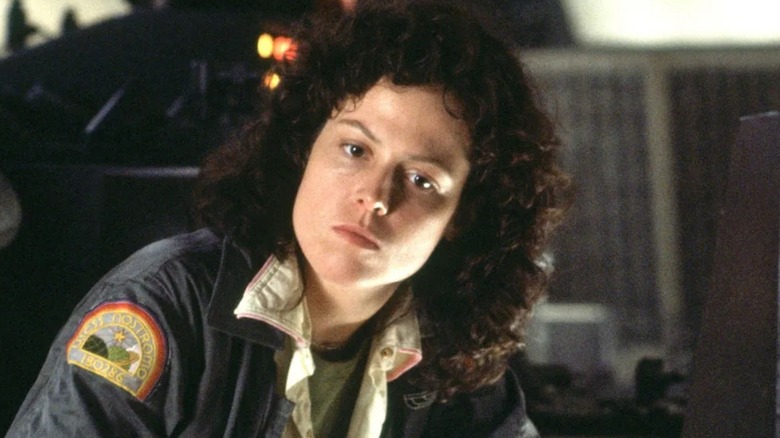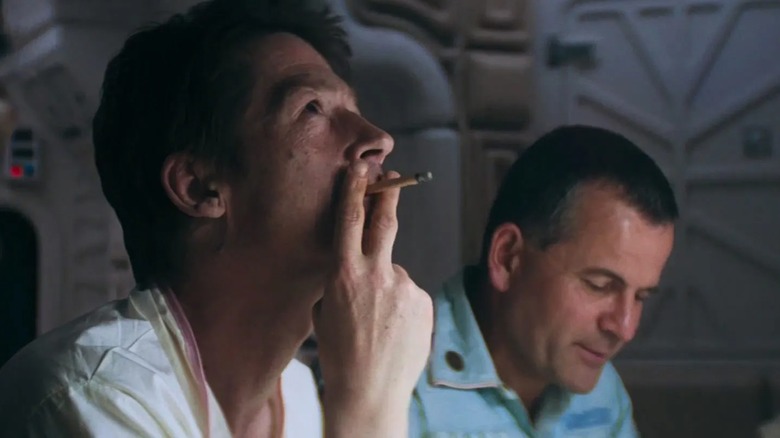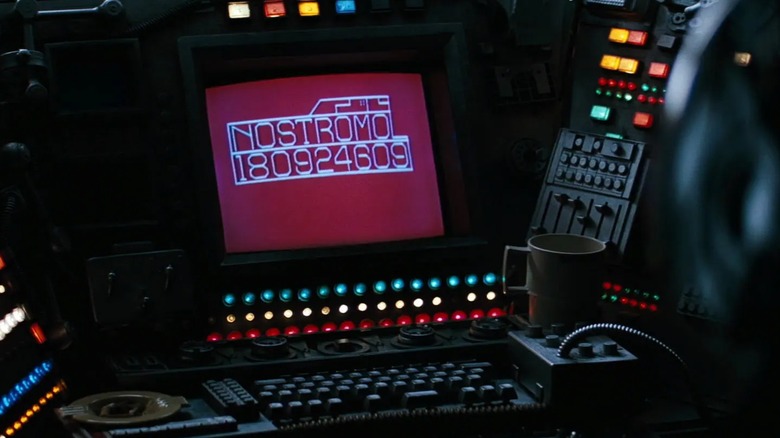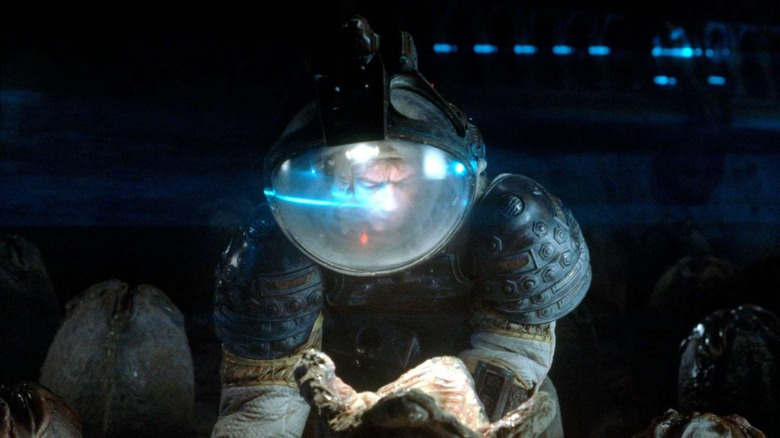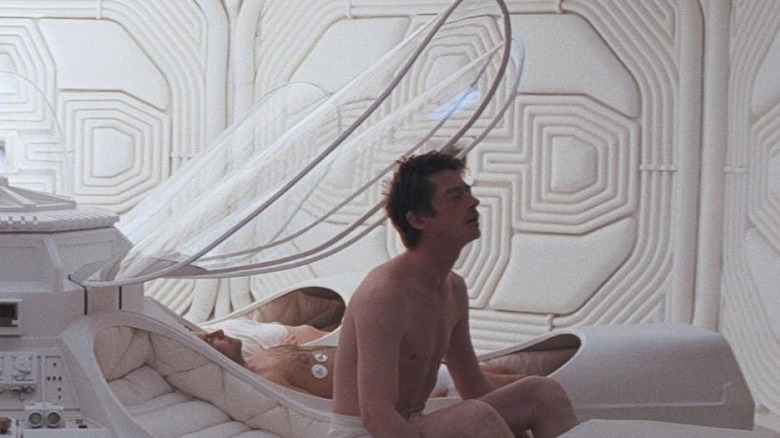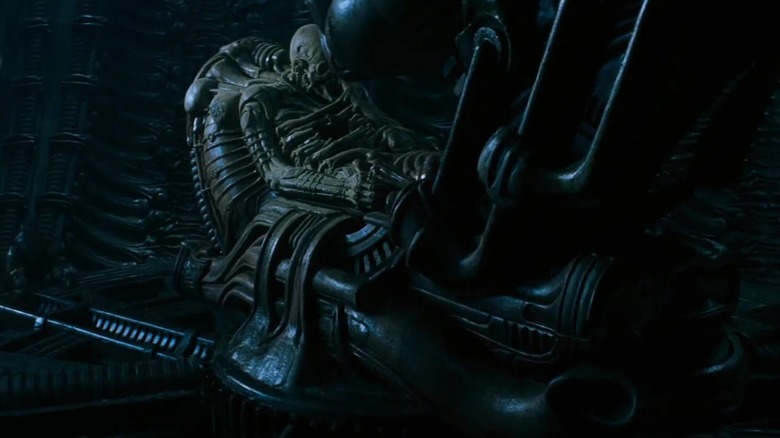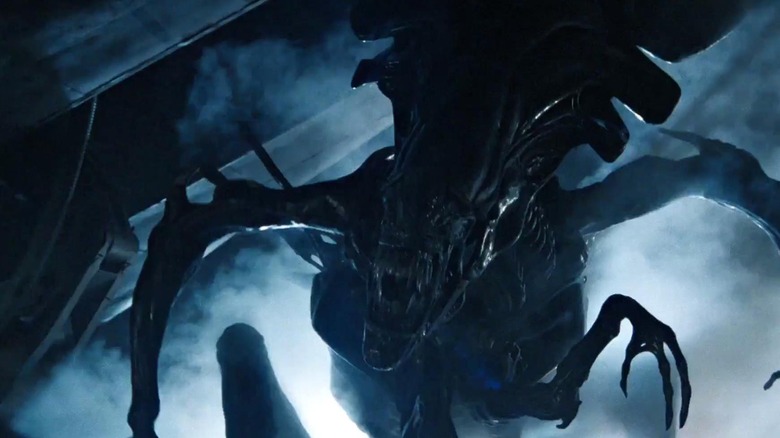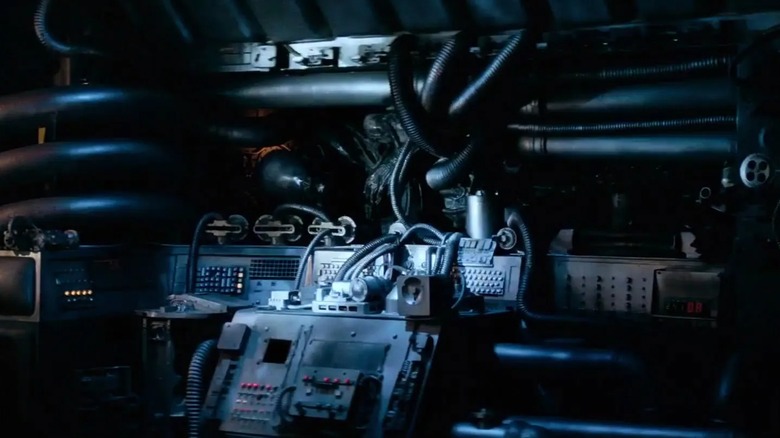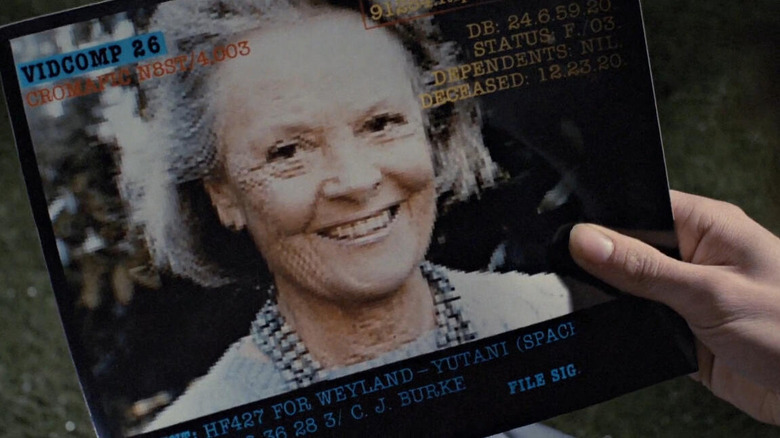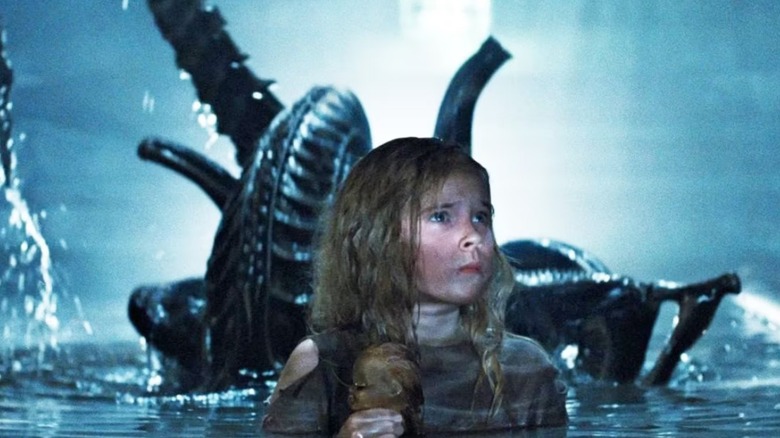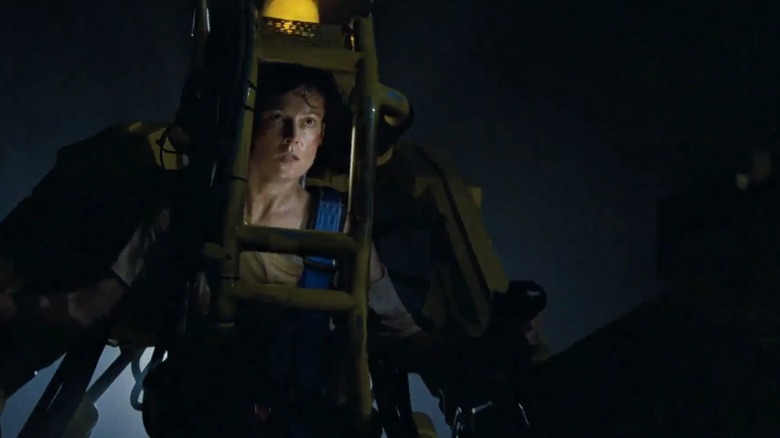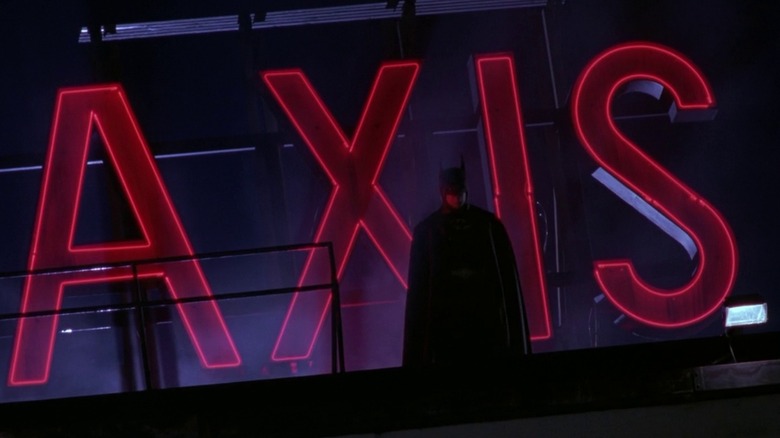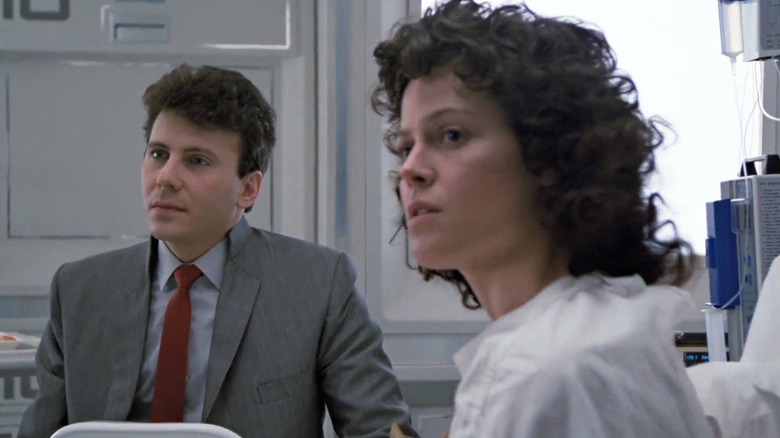We Rewatched Alien And Aliens And Here's What We Noticed
It's a little hard to believe, but the "Alien" franchise has been with us for more than 45 years. Director Ridley Scott kicked off the series back in 1979 with the original "Alien," and since then we've gotten sequels, prequels, and spin-offs galore. Some installments, like "Alien 3," have left fans feeling defeated, while others, like "Alien: Romulus," have blown everyone away. Throughout the franchise's ups and downs, people keep coming back to see what horrors the xenomorph will unleash next.
After all this time, the movies that helped establish this universe look a little different than they used to. Scott's "Alien" is still an inventive piece of work, but when you watch it today, you can't help but see all the other sci-fi properties it helped inspire, James Cameron's game-changing sequel "Aliens" is every bit as entertaining now as it was in 1986, even though we already know who lives and who dies. Rewatching "Alien" and "Aliens" in the 2020s is like having a dream about a place you visited a long time ago on vacation: everything feels vaguely familiar, but you can't shake the surreal feeling that it's all changed somehow.
Everyone is smoking constantly
"Alien" opens with a long tracking shot that meanders through the belly of the Nostromo and reveals the crew's cryopods as the ship begins to wake everyone up. Seeing the crew slowly rise and start interacting with each other and the ship's various systems instantly makes you feel like a part of the movie's world. Sure, those advanced systems now look like retro computers from the '90s, but when you're watching the movie today, it's ironically the humans themselves who pull you out of their reality just a little. That's because the first thing many of them do after waking up is grab a cigarette.
"Alien" was filmed at a time when people could still smoke on airplanes and in college classrooms. Even though the movie is set in the year 2122, that little hallmark of late '70s culture still made its way into the story. Some Nostromo crew members even roll their own cigarettes in various scenes. Trails of smoke add to the ambiance, but they also stick out like a sore thumb when you watch the movie today because its difficult to imagine ship safety protocols that allow for smoking. Hopefully the Nostromo has even better air filtration systems than the real-world International Space Station.
The sets and props are the real stars
No one is going to say that CGI can't look incredible, but when you rewatch "Alien" today, you immediately notice how much the practical effects elevate the movie. Take the opening shot as just one example: As the camera pans through the halls and rooms of the ship, it feels real because it is real. The atmosphere and texture of the set and its lighting immediately come through to viewers. It's impossible not to be engrossed in the world of "Alien" from the get-go, and things only get better when the characters start interacting with the world around them.
The sets and props in "Alien" are responsible for creating some of the most iconic moments in the movie. The space jockey scene is still utterly jaw-dropping because you can feel the Nostromo crew members actually walking through the giant spaceship interior. Every interaction with the ship's computer, Mother, feels tactile and real because the actors are actually sitting inside that sterile, airless computer room. And of course, there's that unforgettable chest-burster scene, done with practical effects on the set. Rewatching "Alien" makes you realize just how much movies have come to rely on CGI, and it's enough to make you wish for a real return to physical, practical visuals.
H.R. Giger has come to define space horror
The props and sets of "Alien" wouldn't stand out nearly as much as they do if it wasn't for the designer behind them. In 1979, general movie audiences weren't familiar with H.R. Giger, an independent artist from Switzerland who arguably never really broke into the mainstream. Without Giger, we might still have the movie "Alien," but we certainly wouldn't have the xenomorph or countless other space horrors that have been inspired by Ridley Scott's original film.
Today more people recognize the xenomorph than the name H.R. Giger, but his designs predate "Alien" by several years. Giger released one of his most iconic works, a painting called "Necronom IV" in 1976, and the image depicts a creature that seems to be made of a bizarre mixture of organic and synthetic parts. After seeing Giger's work, Scott pivoted away from the xenomorph's terrible original design and brought the Swiss artist into the production.
When you rewatch "Alien" now, it's striking just how much Giger's work has come to influence science fiction. His ship designs have been echoed in other movies like 1997's "Event Horizon," and his terrifying alien creatures have become synonymous with sci-fi/horror. Giger's designs have gone beyond film as well: video games like 2022's "Scorn" make players walk through nightmarish worlds ripped straight out of Giger's paintings. On a rewatch, "Alien" feels even more familiar than you'd expect because of just how far and wide Giger's imagery has spread.
The Alien cast's introduction was a total fakeout
Decades after the release of "Alien," there are two characters in the entire movie that most people can tell you about: the xenomorph and Ripley (Sigourney Weaver). In the years since that movie made its debut, multiple sequels have cemented Ripley's place as one of the best sci-fi heroines of all time. The franchise has proven that it can continue without her, but Ripley will always be a key part of the "Alien" mythology.
Ripley's towering stature in the sci-fi genre makes her introduction in "Alien" even more fun to watch now. Back in 1979, most of the movie's cast members weren't well-known stars, and Ridley Scott used that fact to obscure the movie's real protagonist. When the crew first wakes up, the camera follows Kane (John Hurt), and in the scenes that follow, Ripley is just a background player. She hardly has any speaking lines until the search party returns from the crashed ship on LV-426.
"Alien" initially pushes Ripley to the background because she's not really the "hero" of the movie — she's just the only crew member who survives. The sequels turned Ripley into an action hero capable of slaughtering dozens of xenomorphs, so it's easy to forget that when the story began, she was just as scared as any other human encountering a monstrous, unstoppable alien for the first time.
There are hints about the Engineers
The scene in "Alien" where three Nostromo crew members investigate the crashed ship on LV-426 is one of the most haunting moments in the entire franchise. The film drives home the scale of the ship by showing just how tiny the humans are once they're standing inside the cockpit. The corpse of the space jockey provokes terror and curiosity at the same time. For decades, that scene held a slew of unanswered questions. What is that creature in the pilot's chair? How did it die? What was its connection to the xenomorphs?
While we still don't have definitive answers to all those questions, there's significantly less mystery to the space jockey scene now than there was back in the 1970s. Ridley Scott has since directed two movies, "Prometheus" and "Alien: Covenant," that explore the backstory of the space jockey's race, known only as the Engineers. Scott told Movieweb in 2011 that he couldn't believe the "Alien" sequels never explored that bit of franchise backstory. "I always thought it was amazing that no one ever asked who he was, and why was he there?" Scott said. "I sat thinking about this for a while and thought, well, there's a story!"
Scott told that story in the two prequel movies, although it doesn't look likely that his planned third film, "Alien: Awakening," will ever happen. The prequels are good stories in their own right, but its a shame that the space jockey scene has now been robbed of that sense of mystery.
A deleted scene solves one plot hole and creates another
In the original "Alien," the crashed ship that the Nostromo finds on LV-426 is filled with thousands of xenomorph eggs. It takes just one facehugger from a single egg to destroy the entire crew, but the movie never reveals where all those eggs come from. Years later, "Alien" fans got to see a deleted scene where it's revealed that the xenomorph isn't killing the Nostromo crew members but is actually kidnapping them and somehow transforming them into more eggs.
That deleted scene seemingly clears up a small plot hole in the original film, but it introduces an even bigger problem for the franchise as a whole. In James Cameron's sequel "Aliens," we're introduced to the xenomorph queen. She's a bigger, scarier version of the main aliens, and she lays eggs that eventually hatch the monsters that destroy the human colony on LV-426.
In a 2001 interview with journalist Randy Lofficier, Cameron revealed that he knew about the deleted scene from the original film when he was working on "Aliens," but made a conscious decision to take the story in a different direction. "Had the first film appeared in its complete form," Cameron said, "then I would have had to take a different approach to the story. But I felt only a responsibility to what people saw within the first film, not the intentions of various people behind it." Cameron's vision complicates the story of how xenomorphs get made, but having contradictory and incomplete bits of information about the xenomorphs actually makes them even more terrifying.
There are many hidden shots of the xenomorph
One of the joys of rewatching a movie as scary as "Alien" is getting to appreciate all the different techniques the filmmakers used to psych you out the first time around. We could write thousands of words about how "Alien" expertly ratchets up the tension and puts viewers into the minds of the various Nostromo crew members. Instead, we'll focus on just one small detail that most viewers miss the first time they see "Alien."
In a couple of key scenes, the xenomorph can be seen lurking in the shadows behind our beloved characters. When Brett (Harry Dean Stanton) goes looking for Jonesy the cat, the scene stretches on as Brett aimlessly wanders the halls. Careful viewers can occasionally spot the xenomorph's tail as the creature skulks behind him, hunting him so slowly it's almost agonizing. Later, when Ripley is getting ready to take off in the shuttle, she eventually is confronted by the xenomorph, which folds itself up and hides between the pipes inside the ship — but it's there from the very beginning of the scene. The creature is hard to spot in the darkened shuttle, but once you see it, you can't unsee it.
Ripley's missing daughter adds so much to Aliens
There's a scene in "Aliens" that's so crucial to the core themes of the movie we still can't believe it ended up getting cut from the initial theatrical release. From Ripley's relationship with sole colony survivor Newt (Carrie Henn) to her encounter with the xenomorph queen, "Aliens" keeps coming back to the idea of motherhood in one way or another. It's an important subtext that the movie doesn't start developing until about halfway through.
It's obvious now that James Cameron had always planned on expanding that theme, in a scene deleted from the film's original theatrical version but restored for the extended edition released on home video. Very early in the film, just before Ripley has her meeting with the Weyland-Yutani executives, Ripley asks Burke (Paul Reiser) if he's found any information about her daughter. He reveals that in the 60 years since Ripley went into the shuttle's cryopod at the end of "Alien," her daughter has lived out a full life and died.
Ripley's devastation in that scene is deeply moving, and it's a great example of what a spectacular actor Sigourney Weaver is. Aside from showing off Weaver's talent, the scene also lays the groundwork for Ripley's emotional state throughout the rest of the movie, and it provides a solid motivation for her forming a relationship with Newt. The movie as a whole works even better with the scene, so we're thankful that it's available in the extended edition of "Aliens."
Newt shouldn't be alive
There are countless differences between "Alien" and its sequel, but one of the biggest is the presence of Newt. Adding a child character to an action-horror sequel was a bold move on James Cameron's part, but he managed to make Newt a beneficial addition to Ripley's story and the overall movie. Without Newt, Ripley and the Marines probably wouldn't survive on LV-426, and the deeper thematic elements of "Aliens" wouldn't come across at all. We're thankful Newt is in the movie, but on a second viewing, it becomes painfully clear that her presence is a trick that "Aliens" played on all of us.
Ripley and the Marines encounter Newt before all hell breaks loose, when the xenomorphs realize they've come to the colony. Even at that point, it seems amazing that Newt was able to survive for weeks on her own in the colony. After watching the xenomorphs turn basically all of the Marines into shredded meat, you realize that there's absolutely no way Newt could have avoided and outsmarted the aliens for weeks on end. If the movie had thrown a xenomorph battle or two into the mix ahead of Newt's introduction — with the terrifying, relentless nature of the aliens on display — then no one would buy her as a believable character.
James Cameron subverted the final girl trope
"Alien" was groundbreaking in so many ways, but it couldn't help but recreate the "final girl" trope from countless other horror movies. By the end of the film, Ripley is less of a hero than a survivor. She escapes the Nostromo and kills the xenomorph, but her victory is really just a testament to her own luck and endurance. If her story had ended then, Ripley would never have become the iconic hero she is today, and believe it or not, that almost happened.
When James Cameron first began working on "Aliens," there wasn't a guarantee that Sigourney Weaver would return for the sequel. "I was asked to write a story based on Ripley," Cameron later told Randy Lofficier. "Later on it turned out that everybody but us thought that the film could be made without Sigourney Weaver, which completely blew my mind and was absolutely out of the question for us."
As we now know, Cameron had the idea to transform Ripley from a typical horror movie survivor into a bona fide action hero. The hardest person to convince of his idea turned out to be Weaver herself. Cameron has said that he all but tricked Weaver into taking the part by calling an agent who worked at the same firm as Weaver's and pretending that he'd written Ripley out of the script. His plan worked, Weaver signed onto the film, and together they were able to completely flip the script for Ripley as a character.
Batman '89 reused a set from Aliens
There's one detail in "Aliens" that was impossible to spot when the movie first debuted because it didn't exist yet. Much of the movie takes place inside the industrial buildings of the LV-426 colony, with the characters fighting off xenomorphs while running through narrow hallways and ducking under steaming metal pipes. The set that gave shape to most of the movie later went on to play a big role in another film that's become a pop culture icon: "Batman."
One of the most pivotal scenes in Tim Burton's 1989 superhero flick takes place in the Axis Chemical plant, where Jack Napier (Jack Nicholson) falls into a vat of toxic sludge and becomes the Joker. Burton started shooting "Batman" not long after "Aliens" debuted in 1986, and the studio had access to the set that was used for some of the interior shots of the colony in the latter movie. So Burton borrowed the set and LV-426 became Axis Chemicals.
The place looks a little different with Batman running through it instead of the xenomorphs, but if you're watching carefully, you can see that both movies were filmed in the same place. You can also spot a few other borrowed set elements, like Batman's chair in the Batcave, which was originally used on the Marines' personnel carrier.
Capitalism was the bad guy all along
Believing that the xenomorphs are the villains of the "Alien" franchise is an easy enough mistake to make, but on a revisit, it's easy to see that the xenomorphs are really just empty-minded animals carrying out their basic instincts. The xenomorphs are absolutely killing machines, but at least in the world established by the first two movies, they're never ultimately responsible for all the slaughter they commit.
One of the most crushing moments in "Alien" is when Ripley interfaces with Mother and learns that the Nostromo has had a secret mission all along to retrieve samples of alien life from LV-426. Even though she's technically in command of the ship, the company has ordered Ash (Ian Holm) to prioritize bringing the aliens to Earth above all else. In "Aliens," the idea that a profit motive is the real evil becomes even more explicit. The alien attack on the LV-426 colony all starts because Burke wants to retrieve samples that he can sell back to the company for a profit.
The Weyland-Yutani Corporation is clearly modeled after the worst global conglomerates in our own world, and characters like Burke are meant to represent greedy, ladder-climbing corporatists. The company and its employees are willing to risk anything to make more money, and because of their greed, the xenomorphs are unleashed on helpless humans — and have been preying on us at the movies ever since.
